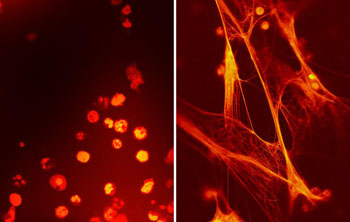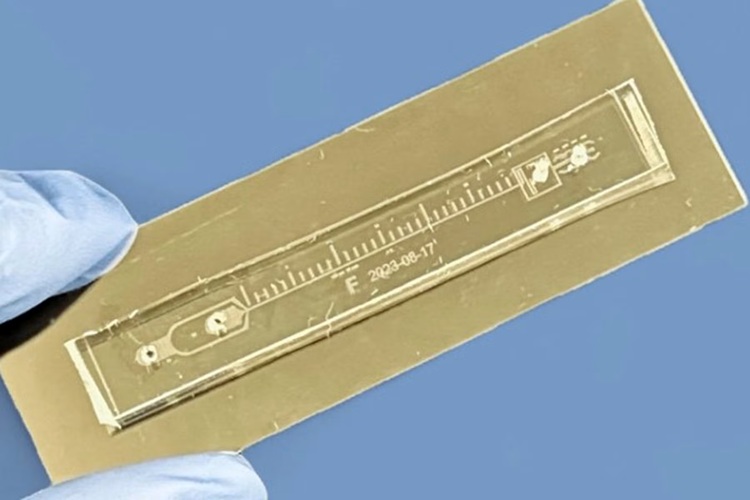Peptide from Umbilical Cord Blood Shuts Down a Neutrophil Inflammatory Factor
|
By LabMedica International staff writers Posted on 19 Sep 2016 |

Image: Infection fighting cells from umbilical cord blood (left) and circulating blood three days after birth (right) from the same prematurely born baby. Umbilical cord blood has high levels of neonatal NET inhibitory factor (nNIF), which inhibits formation of neutrophil extracellular traps (NETs) (Photo courtesy of Mark Cody/Diana Lim, University of Utah Health Care).
Researchers have isolated a peptide in umbilical cord blood that blocks the formation of neutrophil extracellular traps (NETs) and reduces inflammation and risk of developing sepsis.
NETs are molecular lattices of decondensed chromatin embedded with histones, granule enzymes, and antimicrobial peptides that are extruded by immune system neutrophil granulocytes, (polymorphonuclear leukocytes or PMNs) to capture and contain bacteria, viruses, and other pathogens. Experimental evidence has indicated that NETs also cause inflammatory vascular and tissue damage, suggesting that identifying pathways that inhibit NET formation may have therapeutic implications.
After examining various potential sites for the presence of a NET inhibitor, investigators at University of Utah Health Care (Salt Lake City, USA) discovered a peptide in umbilical cord blood that inhibited NET formation in vitro and in vivo and that appeared to be an endogenous regulator of NET generation.
They reported in the September 6, 2016, online edition of The Journal of Clinical Investigation that in addition to this neonatal NET-inhibitory factor (nNIF), they had also identified additional nNIF-related peptides (NRPs) that inhibited NET formation. These nNIFs and NRPs blocked NET formation induced by pathogens, microbial toxins, and pharmacologic agonists in vitro and in mouse models of infection and systemic inflammation, and they improved mortality in mouse models of systemic inflammation.
"We found something we were not expecting, and it has taken us to new strategies for therapy that did not exist before," said senior author Dr. Guy Zimmerman, professor of internal medicine at University of Utah Health Care.
Related Links:
University of Utah Health Care
NETs are molecular lattices of decondensed chromatin embedded with histones, granule enzymes, and antimicrobial peptides that are extruded by immune system neutrophil granulocytes, (polymorphonuclear leukocytes or PMNs) to capture and contain bacteria, viruses, and other pathogens. Experimental evidence has indicated that NETs also cause inflammatory vascular and tissue damage, suggesting that identifying pathways that inhibit NET formation may have therapeutic implications.
After examining various potential sites for the presence of a NET inhibitor, investigators at University of Utah Health Care (Salt Lake City, USA) discovered a peptide in umbilical cord blood that inhibited NET formation in vitro and in vivo and that appeared to be an endogenous regulator of NET generation.
They reported in the September 6, 2016, online edition of The Journal of Clinical Investigation that in addition to this neonatal NET-inhibitory factor (nNIF), they had also identified additional nNIF-related peptides (NRPs) that inhibited NET formation. These nNIFs and NRPs blocked NET formation induced by pathogens, microbial toxins, and pharmacologic agonists in vitro and in mouse models of infection and systemic inflammation, and they improved mortality in mouse models of systemic inflammation.
"We found something we were not expecting, and it has taken us to new strategies for therapy that did not exist before," said senior author Dr. Guy Zimmerman, professor of internal medicine at University of Utah Health Care.
Related Links:
University of Utah Health Care
Latest BioResearch News
- Genome Analysis Predicts Likelihood of Neurodisability in Oxygen-Deprived Newborns
- Gene Panel Predicts Disease Progession for Patients with B-cell Lymphoma
- New Method Simplifies Preparation of Tumor Genomic DNA Libraries
- New Tool Developed for Diagnosis of Chronic HBV Infection
- Panel of Genetic Loci Accurately Predicts Risk of Developing Gout
- Disrupted TGFB Signaling Linked to Increased Cancer-Related Bacteria
- Gene Fusion Protein Proposed as Prostate Cancer Biomarker
- NIV Test to Diagnose and Monitor Vascular Complications in Diabetes
- Semen Exosome MicroRNA Proves Biomarker for Prostate Cancer
- Genetic Loci Link Plasma Lipid Levels to CVD Risk
- Newly Identified Gene Network Aids in Early Diagnosis of Autism Spectrum Disorder
- Link Confirmed between Living in Poverty and Developing Diseases
- Genomic Study Identifies Kidney Disease Loci in Type I Diabetes Patients
- Liquid Biopsy More Effective for Analyzing Tumor Drug Resistance Mutations
- New Liquid Biopsy Assay Reveals Host-Pathogen Interactions
- Method Developed for Enriching Trophoblast Population in Samples
Channels
Clinical Chemistry
view channel
Chemical Imaging Probe Could Track and Treat Prostate Cancer
Prostate cancer remains a leading cause of illness and death among men, with many patients eventually developing resistance to standard hormone-blocking therapies. These drugs often lose effectiveness... Read more
Mismatch Between Two Common Kidney Function Tests Indicates Serious Health Problems
Creatinine has long been the standard for measuring kidney filtration, while cystatin C — a protein produced by all human cells — has been recommended as a complementary marker because it is influenced... Read moreMolecular Diagnostics
view channel
New Genetic Test Enables Faster Diagnosis of Rare Diseases
Rare disease diagnosis often involves a long and uncertain search for the underlying genetic cause. Traditional testing requires multiple separate analyses, although many patients remain without answers.... Read more
Urine Test Detects Inherited Neuropathy Missed by Genetic Screening
Sorbitol dehydrogenase (SORD)-related neuropathy is one of the most common inherited nerve disorders, yet diagnosis often lags because current genetic screens frequently miss the causal gene.... Read moreHematology
view channel
Platelet Activity Blood Test in Middle Age Could Identify Early Alzheimer’s Risk
Early detection of Alzheimer’s disease remains one of the biggest unmet needs in neurology, particularly because the biological changes underlying the disorder begin decades before memory symptoms appear.... Read more
Microvesicles Measurement Could Detect Vascular Injury in Sickle Cell Disease Patients
Assessing disease severity in sickle cell disease (SCD) remains challenging, especially when trying to predict hemolysis, vascular injury, and risk of complications such as vaso-occlusive crises.... Read more
ADLM’s New Coagulation Testing Guidance to Improve Care for Patients on Blood Thinners
Direct oral anticoagulants (DOACs) are one of the most common types of blood thinners. Patients take them to prevent a host of complications that could arise from blood clotting, including stroke, deep... Read moreImmunology
view channel
Chip Captures Cancer Cells from Blood to Help Select Right Breast Cancer Treatment
Ductal carcinoma in situ (DCIS) accounts for about a quarter of all breast cancer cases and generally carries a good prognosis. This non-invasive form of the disease may or may not become life-threatening.... Read more
Blood-Based Liquid Biopsy Model Analyzes Immunotherapy Effectiveness
Immunotherapy has revolutionized cancer care by harnessing the immune system to fight tumors, yet predicting who will benefit remains a major challenge. Many patients undergo costly and taxing treatment... Read moreMicrobiology
view channel
Rapid Assay Identifies Bloodstream Infection Pathogens Directly from Patient Samples
Bloodstream infections in sepsis progress quickly and demand rapid, precise diagnosis. Current blood-culture methods often take one to five days to identify the pathogen, leaving clinicians to treat blindly... Read more
Blood-Based Molecular Signatures to Enable Rapid EPTB Diagnosis
Extrapulmonary tuberculosis (EPTB) remains difficult to diagnose and treat because it spreads beyond the lungs and lacks easily accessible biomarkers. Despite TB infecting 10 million people yearly, the... Read more
15-Minute Blood Test Diagnoses Life-Threatening Infections in Children
Distinguishing minor childhood illnesses from potentially life-threatening infections such as sepsis or meningitis remains a major challenge in emergency care. Traditional tests can take hours, leaving... Read more
High-Throughput Enteric Panels Detect Multiple GI Bacterial Infections from Single Stool Swab Sample
Gastrointestinal (GI) infections are among the most common causes of illness worldwide, leading to over 1.7 million deaths annually and placing a heavy burden on healthcare systems. Conventional diagnostic... Read morePathology
view channel
Blood Test and Sputum Analysis Predict Acute COPD Exacerbation
Chronic obstructive pulmonary disease (COPD) remains a major contributor to global illness, largely driven by cigarette smoking and marked by irreversible lung damage. Acute exacerbations can accelerate... Read more
AI Tool to Transform Skin Cancer Detection with Near-Perfect Accuracy
Melanoma continues to be one of the most difficult skin cancers to diagnose because it often resembles harmless moles or benign lesions. Traditional AI tools depend heavily on dermoscopic images alone,... Read more
Unique Immune Signatures Distinguish Rare Autoimmune Condition from Multiple Sclerosis
Myelin oligodendrocyte glycoprotein antibody–associated disease (MOGAD) is a rare autoimmune disorder in which the immune system attacks the myelin sheath in the central nervous system. Although symptoms... Read moreTechnology
view channel
AI Saliva Sensor Enables Early Detection of Head and Neck Cancer
Early detection of head and neck cancer remains difficult because the disease produces few or no symptoms in its earliest stages, and lesions often lie deep within the head or neck, where biopsy or endoscopy... Read more
AI-Powered Biosensor Technology to Enable Breath Test for Lung Cancer Detection
Detecting lung cancer early remains one of the biggest challenges in oncology, largely because current tools are invasive, expensive, or unable to identify the disease in its earliest phases.... Read moreIndustry
view channel
Abbott Acquires Cancer-Screening Company Exact Sciences
Abbott (Abbott Park, IL, USA) has entered into a definitive agreement to acquire Exact Sciences (Madison, WI, USA), enabling it to enter and lead in fast-growing cancer diagnostics segments.... Read more









 (3) (1).png)














